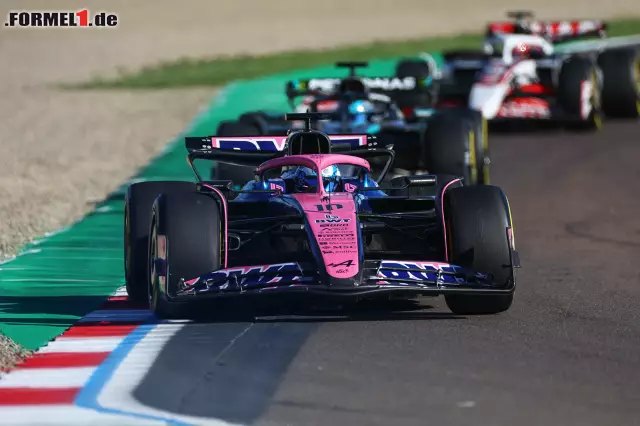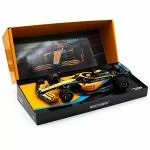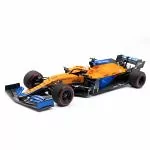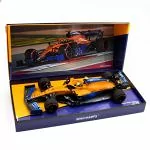What we learned from Friday practice in Imola

(Motorsport-Total.com) - Nobody builds anything like Imola anymore. When you think of legendary corner combinations in motorsport, the Maggotts/Becketts at Silverstone or the Esses with their transition into the Degners at Suzuka quickly come to mind. Or the Porsche Curves at Le Mans? The Corkscrew at Laguna Seca? Eau Rouge up to Raidillon at Spa?
For my taste, the descent from Piratella towards Acque Minerali and the subsequent climb to the Variante Alta is a massively underrated combination.
It would be a shame to lose Imola from the Formula 1 calendar, but it would come as no surprise - the track feels like it's out of date, too small for the spectacle that the Grand Prix circuit has become over the last decade.
If the cars were a little smaller, it would certainly help the racing experience, but even the 2026 rule changes that are supposed to shrink the cars barely scratch the surface of what would be needed.
You leave Tosa, step on the gas, shift into seventh gear, and approach the top of the hill. Brake—but not too hard, just enough to reduce speed—and with a pull of the left paddle, you shift into sixth gear.
Pierre Gasly (Alpine) Gallery
You briefly ease off the accelerator, but immediately ramp it up again as you approach the apex. It's a cautious process, because the run-off point is eagerly awaiting anyone who overdoes it.
Then it's a steep descent. The car hits the lowest point, scraping its underbody against the asphalt as the dampers compress – and only after the first part of Acque Minerali does the brakes come on with a hesitant left foot. Third gear, the car responds, and it begins the climb to the Variante Alta.
McLaren ahead on FridayOf the two McLarens at the front in the second practice session, it was Oscar Piastri who mastered the descent best - but Lando Norris was a little quicker coming out of the double right-hand combination Acque Minerali.
In the end, they were separated by just 0.025 seconds on their best laps on Pirelli's new C6 compound. Piastri even had room to improve if he had made a better exit from Rivazza and hadn't been slowed by traffic and dust.
In terms of top speed, the McLarens in qualifying trim weren't outstanding; Pierre Gasly, in third place, was even faster in the acceleration zones. But in the corners, McLaren played to its strengths and made up time there. Had the Mercedes engine been tuned down a bit?
Possibly—although Norris himself said he expects a smaller lead on Saturday. That may be due more to his cautious nature.
"We always look good in FP2," said Norris. "We always look much better than everyone else. And then qualifying comes along, and they're catching up. I don't think we're in a comfortable position. We still have work to do."
"Alpine was fast. They've always been fast here. And I'm sure Red Bull will catch up, and Mercedes too - once they rev their engines. So no reason to relax," said the Briton.
McLaren knows how important a good qualifying is here – otherwise, they risk a déjà vu like at Suzuka, where they couldn't convert their strong race pace into a good result. Norris named Red Bull and Mercedes as their main rivals, each looking for that decisive one-lap performance to secure an advantageous starting position for Sunday.
Even though George Russell was 0.4 seconds behind Piastri's fastest time, he was still within striking distance – especially since the Mercedes driver only completed one lap on soft tires. And Max Verstappen can never be written off anyway – last year, he was hardly in contention for pole on Friday at Imola, but Red Bull's steady improvement ultimately landed him on the front row.
McLaren wants to avoid the specter of Suzuka, where qualifying cost everything, but there's one aspect that makes the situation somewhat different: the tires. Pirelli has introduced the new C6 this year, an even softer compound than last year.
This could suit McLaren, as the medium tire (formerly the soft) exhibits high wear—ideal for teams that want to play tactically with a tire offset. And McLaren is strong in this area.
Long run analysis: McLaren ahead, short runs conceal deteriorationMany long runs were interrupted by Isack Hadjar's slip-up at Tamburello. The Frenchman lost control while accelerating out of the pit lane, drove through the gravel trap, lightly touched the wall, and was initially able to continue – but when he tried to extricate himself from the danger zone, he got stuck.
Nevertheless, some long-run plans could be analyzed - however, no one tested the durability of the C6, everyone switched to mediums for the racing simulations.
The red flag prevented us from closely observing the degradation of the C5 in a race simulation - but the first laps past the ten-lap mark showed that the time loss was noticeable.
Average long runs on medium in FT2: McLaren (Piastri) - 1:20.043 minutes - 8 laps Ferrari (Leclerc) - 1:20.189 - 7th Mercedes (Antonelli) - 1:20.271 - 8th Racing Bulls (Hajar) - 1:20.351 - 7th Williams (Sainz) - 1:20.442 - 7th Red Bull (Verstappen) - 1:20.663 - 10th Alpine (Gasly) - 1:21.007 - 12 Sauber (Hülkenberg) - 1:21.143 - 9 Haas (Bearman) - 1:21.369 - 10th
Aston Martin missing - longest run only 4 laps
Unsurprisingly, McLaren topped the list; Piastri and Norris set very similar times, but with Piastri completing a lap more and Norris in traffic, the Australian was used as the reference here.
It seems logical that Mercedes will be McLaren's biggest challenger on Sunday. Antonelli consistently drove low 1:20 lap times, and Russell would likely have been even faster had he not found himself behind Franco Colapinto in the "2025 Lap Simulator."
Ferrari is a special case: Leclerc was strong on his shorter long run, posting several 1:19 laps. Hamilton, on the other hand, averaged 1:20.723 with the same tire window—a large window for Ferrari. A similar picture for the Racing Bulls, who shined thanks to Hadjar's good laps here, but were unable to show consistency due to the crash.
Red Bull was likely running with reduced engine power, but the pace wasn't impressive in either qualifying or race trim. Yuki Tsunoda was at least close to Verstappen—a tenth on one lap, but about 0.3 seconds behind per lap in the race. Colapinto certainly didn't help Verstappen with his track position either...
Williams performed solidly, perhaps even ahead of Alpine, at least in the C6. Carlos Sainz and Alexander Albon were fast in the C5, but quickly lost performance over the lap. Williams was more consistent in race pace—although Sainz's short stint doesn't allow for any indication of deterioration.
Gasly's long run, however, clearly showed the drop-off; he consistently fell into the 1:21 range in the final laps - although traffic (and a stray rabbit) may have played a role here as well.
Tire strategy: One-stopper better for track position - but two-stopper fasterPirelli brought the softest compounds to Imola in the hopes of making the strategy a bit more interesting. Chief engineer Simone Berra says: "It's going to be tricky because we've brought the softest selection this time. Compared to last year, you have to use the C5 in the race, and if you only want to make one stop, you have to significantly extend the first or last stint – depending on the starting compound."
"Teams will attempt a one-stop because track position is crucial here—there's only one real overtaking opportunity, before Turn 2. But they'll have to hold out for a very long time with the C5. On paper, the two-stopper is faster, even with good tire care."
"The strategy will depend heavily on the race situation, but both variants are conceivable. Compared to last year, this is strategically more interesting – so we hope for a more varied race," said Berra.
Stretching the C5 will be difficult and requires early strategic decisions. Those who take this route will have to significantly slow down—this opens up the possibility for opponents behind them to adopt an aggressive two-stop approach, with more speed and a better finish thanks to tire offset.
formel1









